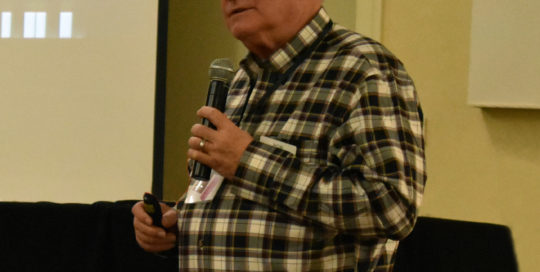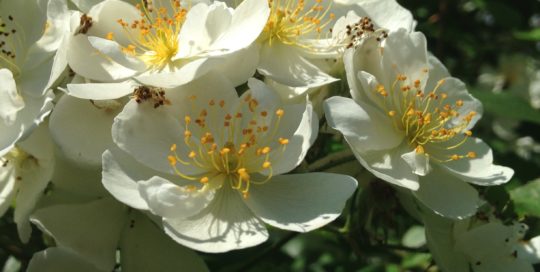Remembering the man, George Doorakian
Views: 800

Bye, bye Hurricane Henri, and hello Hurricane Ida!
For now, the rains have subsided. The temperatures are quickly moving their way to the mid 80’s. Clear skies are forecast for the remainder of the day. Hurricane Henri has done his damage and is now one for the books. His story is done. Hurricane Ida is the new hurricane we all need to worry about. She is the main and most important news story of the day. She has done her damage to New Orleans and the surrounding areas today – exactly sixteen years after Hurricane Katrina wreaked her havoc.
Time will tell the extent of Ida’s destruction. She’s moved on from New Orleans and is headed our way. She will be unleashing many hundreds of thousands of gallons of water (and high winds) as she makes her way east.
Some roses from the man, Mr. George Doorakian
Around me are some 20+ containers full of roses from the man. A small but very important reminder to me of the man. They were his choices in roses. The ones he wanted and put in his yard for him and his wife to enjoy. His name was George Doorakian. He passed away exactly one year ago today after a long battle with ailing health. He was a genius, and knew so much about so many different topics. It came naturally to him. I only got to know him during the last few years of his life, but the impact he has had on me will remain with me until the day I die.
Meeting with the man
My first encounter with the man was met with some trepidation. A fear that I might not live up to his standards. A fear that somehow he was better than me, because he has had many introductions in the world of daylilies, while I had none in the world of roses. But, at a local society meeting, my fears were put at ease. The man was approachable. And, his knowledge of daylilies and roses was truly remarkable. I was aware of some of his accomplishments in the world of daylilies, but not roses until a few years later. Hybridizing was his passion. He lived and breathed crossing different mothers and fathers with each other trying to get just the right combination, and make that “perfect” seedling.
Touring his garden
During a tour of his garden after one of our rose society meetings, he enthusiastically pointed out some of his accomplishments in creating new cultivars, and they were great! A rose here – hardy to zone 3 and fully-engulfing a 10’ x 6’ arbor. One big mass of pink, the sight of which I will remember for many years to come. A dozen daylilies there. All created by his own hand. This one has too much green. This one has too much yellow. Not distinctive enough – it won’t make the cut.
Over there are a hundred more just like these in the next bed. George planned to slowly whittle these many daylilies down to just a few that are distinctive enough to be introduced. I don’t know how far George got in sorting out these seedlings before he passed, but I hope that he was able to find the “perfect” ones for introduction.
Dogwood trees and the need to be white
We walked another twenty feet and George showed me a fully-grown dogwood he hybridized. And, another one there. Just a hint of pink in the bloom, and that will not do. And another dogwood seedling there – that one has pink in it too. A hint of pink is visible around the edges on this one, as well. Nope, that’s not good either. All white is what he’s after – no pink allowed. Nothing else will do.
Over there there’s a dozen more hybrid trees and sports of trees and shrubs as well. He’s either found these specimens, or created them by his own imagination and knowledge of the different species. And, he’s proud of each and every one of them – just like so many other hybridizers who are proud of their “babies” (including me).
Discussions with the man
When we met again at another local rose society meeting, we talked about what else? Roses. But, what was different this time was the special nuances that we were able to discuss. We discussed plaint ploidy (number of pairs of chromosomes). We discussed distinctiveness of seedlings, and why that’s important. And, we discussed the naming of roses (and daylilies) for the special people in our lives. Through our discussions, we were able to communicate at a level I have never have had the opportunity to do so in the past (and probably never will again). While we discussed our plant “babies,” we also discussed our families and the support and love that they give to us in our pursuit of our dreams in the horticulture world.
I looked forward to our discussions during and after the many society meetings that we both attended. The knowledge and wisdom that George possessed about roses, daylilies, and horticulture in general was vast and will be missed by a great many who knew him.
Some of the man’s accomplishments in roses
While George may be more well-known for his accomplishments in the world of daylilies, he should also be known and accepted for his accomplishments in the world of roses. I’m on a small mission to do my part to make that happen. He hybridized many roses and some were hardy to zone 3. No minor accomplishment at achieve. Floriferous? Absolutely. At least one of his seedlings has the ability to completely engulf an arbor (or two) in his zone five garden. Rose horticulture knowledge? Unsurpassed. Education? That’s what he did best – pass along as much knowledge as possible to as many people as he could.
George also knew the many nuances of dogwoods, daylilies, Japanese maples, rhododendrons, magnolias, and any number of other plant species. He helped to organize a Mini National Convention put on by the New England Rose Society back in the 1990’s. He was an exhibitor of roses and daylilies and received many awards for his entries. Among them is the Massachusetts Horticulture Society 18 Carat Gold Medal Award and the American Rose Society Gold Medal Certificate. He received these awards for a display of 500 roses he entered in one of the shows. He is the only person I know to have won these awards as well as the Stout Silver Medal for his Rose F. Kennedy daylily.
The man was a scientist
George was a scientist for many years with many patents to his name. He transferred much scientific knowledge to his horticulture endeavors and tried various methods to genetically alter the DNA within his hybrids. We had a long discussion at his home where he showed me some of the ways he accomplished this. While I did get the opportunity to get to know George and learn what I could along the way, there was so much more that we were not able to cover. The world lost a valuable resource in the world of roses and daylilies last August 30th, and his name was George Doorakian.
Rest in peace, George
Rest in peace, George. The world is a better place because of the work you did in chemistry and horticulture here on earth. You were one of the people who made a difference in many lives (including mine). I have only scratched the surface on the complex man that you were. But, I wanted to share with the world your name and some of your many accomplishments in roses and daylilies.
Saving George’s seedlings
Since George’s passing, my daughter, her fiancé, and I have gone to his house to remove some unwanted roses that are in the containers all around me, and to get cuttings of his seedlings to clone and share with interested parties. We took cuttings from five plants. Four were confirmed by George’s widow as his seedlings. Two were the same cultivar, and one was unconfirmed as one of his seedlings (but I think that the rose is indeed another one of his seedlings).
I have successfully rooted all of the four cultivars and have already started sharing these cuttings with others. I’m trying to get these seedlings in more than one garden to help thwart any natural disasters that may render them extinct, if they were only in my garden. Hopefully, we will be able to save all of George’s seedlings from becoming extinct, and part of his rose legacy will remain intact for future generations to enjoy (as well as the genetics within).
Epilogue
This story was written with a couple of my fountain pens. I used them at various times while travelling with my daughter and her fiancé the day we took cuttings from George’s garden. I added to the story while on vacation in New Hampshire in the cabin one night. The pens I used were my trusty blue Osmiroid pen and my wooden hand-made pen my wife gifted me for Christmas. I have since discovered that this hand-made pen is made from wood from a tulip tree. Go figure.
When we were taking cuttings from the roses in George’s garden, there were many things that were blooming not only the roses. One of the blooms that caught our eyes was a magnolia tree (Magnolia macrophylla) that had blooms that were some 10-12 inches wide. What a sight to see these large blooms, and what a statement to George and his ability to have such a beautiful and diverse garden.
Meet Andy Vanable
Andy's Recent Posts

The Rose-Growing World Loses an Icon – Bob Martin






